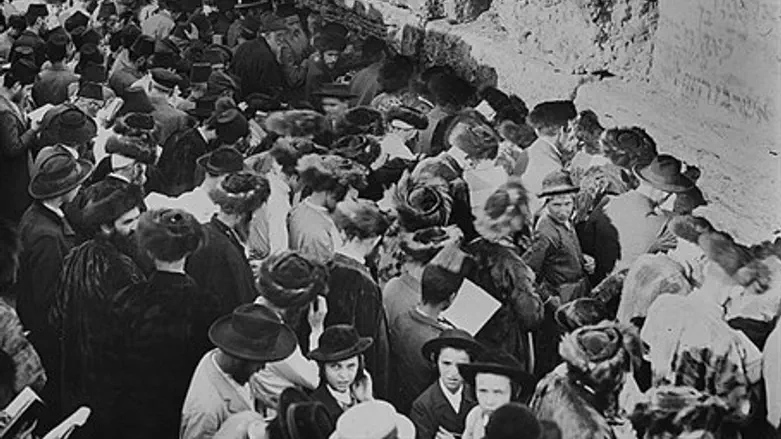
On the main page are Jews at the Kotel on Yom Kippur (circa 1904) . The graffiti on the Wall are memorial notices.
Several readers commented on the intermingling of men and women in these historic pictures.
The Turkish and British rulers of Jerusalem imposed restrictions on the Jewish worshippers, prohibiting chairs, forbidding screens to divide the men and women, and even banning the blowing of the shofar at the end of the Yom Kippur service.
Another view of the Western Wall on Yom Kippur. Note the various groups of worshippers: The
Ashkenazic Hassidim wearing the fur shtreimel hats in the foreground, the Sephardic Jews
wearing the fezzes in the center, and the women in the back wearing white shawls. (circa 1904)
The Library of Congress collection contains many pictures of Jewish worshippers at the Western Wall over the last 150 years.
After the 1967 war, the Western Wall plaza was enlarged and large areas of King Herod's wall have been exposed. Archaeologists have also uncovered major subterranean tunnels -- hundreds of meters long -- that are now open to visitors to Jerusalem.
Original caption: Men and boys standing in
front of synagogue on Yom Kippur (Bain
News Service, circa 1907)
Worshippers in front of synagogue (Bain
News Service, 1907)
And a Picture of Jews in the Prussian Army Worshipping on Yom Kippur 140 Years Ago
This lithograph depicts the Kol Nidre service performed on Yom Kippur 1870 for Jewish soldiers in the Prussian army stationed near Metz (Alsace region) during the Franco-Prussian War of 1870-71.
The Germans had occupied Metz by August of 1870, however were unable to capture the town's formidable fortress, where the remaining French troops had sought refuge. During the siege, Yom Kippur was marked while hostilities still continued, as depicted in the lithograph.
Of all the things in my grandfather's house, I remember most vividly a large print. It was entitled "Service on the Day of Atonement by the Israelite soldiers before Metz 1870." Later I was to learn that this print hung in many Jewish homes.... It was reproduced on postcards, on cloth, and on silk scarves. The basic theme was the same: in an open field before Metz, hundreds of Jewish soldiers were shown at prayer.
Another participant in the unusual Yom Kippur service reported, according to Plaut:
Of the 71 Jewish soldiers in the Corps some 60 had appeared. Amongst them were several physicians, a few members of the military government, all of them joyously moved to celebrate Yom Kippur. The place of prayer consisted of two small rooms.



